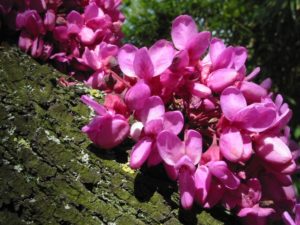These color names appear in the 16th-century Istanbul estate records I analyzed.
Ottoman Turkish drew color names from Persian and Arabic as well as native Turkish, so the language has several sets of duplicate color names: beyaz and ak for white, kırmızı, sürh, and al for red, sebz and yeşil for green, etc. Nowadays some of the synonyms have disappeared, become specialized, lost their separate meanings, or developed new distinctions. When possible, I’ve winkled out the older color meanings.
The words that appear in the records change over time. Late-period words are more varied; early-period words are a much smaller set that don’t overlap much with the later words.
Late 16th Century Color Words
Kırmızı, red. The name is a cognate of kermes, the insect that was used to produce bluish-red dyes. The color red was wildly popular–at least 164 garments were described as red, covering just about every class of clothing.
Al, an Arabic-derived term for red that was already old-fashioned in the 16th century.
Sürh, red. From a Persian word for red, surh.
Kızıl, scarlet and other reds in the yellow-brown portion of the spectrum. [link] Only one garment, a zıbın of the luxury fabric called Bağdâdî, was described as kızıl. The more usual word for orange-reds was probably sürh.

The Judas flower.
Image credit: Bouba
Erguvânî or erguvan, literally “Judas-flower.” Suraiya Faroqhi describes the color as “a blue-tinged red” [link]; I would call it hot pink, fuchsia, or magenta. Of the six erguvani garments in the estate records, five belonged to or were willed to women.
Gülgûnî, vermilion (literally “rose-colored”). Eight of the eleven rose-colored garments in the estate records belonged to İsmihan Hatun bt. İlyas. All the garments either belonged to or were willed to women.
Nârenci, orange.
Turuncu, orange.
Sarı, yellow. Women owned more yellow garments than men, 17 to 9. The color was used most often on zıbıns (7), cames (4), kaftans (6), and detached sleeves (4), most of which would be visible when the wearer was at home, but not on the street.
Kibritî (or kibridî), light yellow. Literally sulphur yellow. There were four light yellow garments–two kaftans, a zıbın, and a pair of diz çakşır–three of which belonged to women. Three of the four garments were expensive; one was of Atlas silk, and another was of kemha brocade. I suspect there are so few light yellow garments listed, and the garments are so expensive, because only wealthier people had wardrobes so extensive that it was necessary to distinguish light yellow from regular yellow.
Yeşil, green. Green was apparently considered a modest, retrained color suitable for outerwear; 46 of the green garments, or 58%, were feraces, while most of the rest were dolama, kaftans, çukas, kürdiyes, and raincoats. Women also wore green zıbıns.
Sebz or sebze, green. From the Persian sabz.
Elmasî, apple-colored. I think it means apple-green.
Neftî, literally naphtha green. A dark green that one source calls green-black, and another calls dark greenish-brown.
Mâî/Ma’i (the formal word) or mavi (colloquial), medium blue. Medium blue was an all-purpose color, used by both men and women for a broad variety of garments. As a lighter color, it was used for inner clothing–zıbıns, kaftans, belts, and trousers. Only two women and five men had medium blue outer garments, and only men wore medium blue feraces.
Sürmâî, dark blue. All six dark blue garments in the estate records were kaftans. Most were expensive–the average cost was 1,061 akçes–and three were noted as being made of kemha or seraser.
Lâciverd, navy blue. From the Persian word for lapis lazuli. It’s unclear whether this is a different shade than sürmai. In the estate records, men had five times as many navy blue garments as women. The color was considered especially appropriate for sober, respectable outer clothes–feraces, dolamas, yeleks, and kürdiyes.
Mor, purple. Considered a dark, sober color. Especially popular for feraces and men’s trousers.
Nohudî, the color of chickpeas (nohud).
Sincab rengî, the color of squirrel fur.
Beyaz, white.
Ak, an old-fashioned Arabic-derived word for white.
Siyah, black. From Persian. The Turkish word, which isn’t used as a color name in the late 16th-century estate records, is kara. Of the 29 black garments in the estate records, 19 are feraces. There are also two kapamas, three dolamas, one kaftan, one zıbın, and three belts.
Early 16th Century Color Words
Al, red.
Kızıl, red.
Asumani, blue (literally “heavenly”).
Elmasî, apple-colored.
Gök, blue.
Sürmâî, dark blue.
Mor, purple.
Benefş, violet.
Beyaz or ak, white.
Siyah, black.
Kara, black or dark.
Boz, gray.
Kır, gray.
Color Names that Didn’t Appear in the Records
darçıni, cinnamon
tutegi, bright green
cevzi, “walnut green”
aseli, honey
fıstıki, pistachio
fındıki, hazelnut
kamışi, strawberry
anberbuyi
ateşi
kahverengi, brown
şarabi, wine
baldırcani (patlıcani), eggplant
deve tüyü, camel
gibileri
https://books.google.com/books?id=5FiTDAAAQBAJ&pg=PT253&lpg=PT253&dq=ottoman+turkish+textile+terms&source=bl&ots=ctNS72OVPw&sig=8HDtNDxrmdHy8OzB1yLPk5FriyU&hl=en&sa=X&ved=0ahUKEwifmcChp77TAhUM8IMKHeZJC20Q6AEISTAF#v=onepage&q=ottoman%20turkish%20textile%20terms&f=false
https://books.google.com/books?id=dJk3AAAAIAAJ&pg=PA73&lpg=PA72&ots=D86ekWy1H3&focus=viewport&dq=ottoman+turkish+color+names#v=onepage&q=ottoman%20turkish%20color%20names&f=false
http://www.gruppodelcolore.it/Docs/AttiGdC_ENG_Torino2016_pro.pdf
https://www.scribd.com/document/50196632/Osmanlilarda-Bir-Kucuk-Sanayi-Ornegi-Selanik-Cuha-Dokumaciligi-1500-1650-an-Ottoman-Smal-Scale-Industry-a-Case-Study-the-Woollen-Manufacture-in-Saloni



